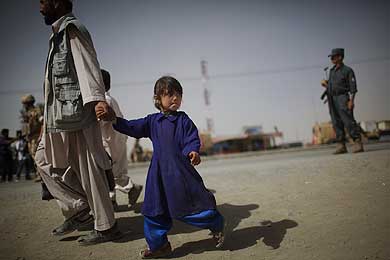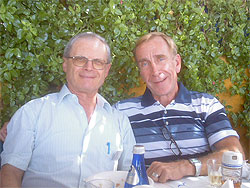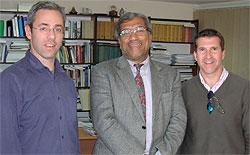Wars have obvious victims. The dead, the injured. Those left behind.But there is another class of victims that often goes unnoticed: children. Not kids who are abducted or killed, but those who simply witness acts of ethnic or political violence, and whose lives and behavior are changed forever.

Children are most vulnerable to exposure to politcal violence. They come to see the world as a hostile place, which has long-term implications for global development.
“Violence is really like a contagious disease,” says Rowell Huesmann, director of the Research Center on Group Dynamics at the University of Michigan’s Institute for Social Research (ISR). “Except in one sense, it’s worse. With contagious diseases, you have to be near the person in order to get it. Violence is contagious even at a distance.”
Huesmann has studied the impact of violence on children in a number of contexts. Most well known is his research showing kids who watch lots of violent TV programs or movies, or who often play violent video games, become more aggressive. He also has studied how community and peer violence affect kids in inner city neighborhoods.
But Huesmann wanted to take it a step further, to go to a part of the world where he could study how relentless exposure to ethnic or political violence affects aggressive behavior and post-traumatic stress (PTS) symptoms, like worry and sadness, among young people.
Given the world’s state of turmoil, there were plenty of locations to consider. But Huesmann also wanted a crackerjack team of collaborators who would know specific territories. He found those collaborators in the Middle East, a region rife with incidents of political violence. At least 4,860 Palestinians and 731 Israeli civilians and 332 Israeli soldiers were killed in political violence from the beginning of the second intifada—or Palestinian uprising—in September 2000 until the start of the Gaza War on Dec. 26, 2008, according to B’Tselem, the Israeli Information Center for Human Rights in the Occupied Territories.
Finding the right team for the job
With funding in 2005 from the National Institutes of Health, Huesmann and six other researchers set to work. In the U.S. were Paul Boxer of Rutgers University, Jeremy Gingis of the New School for Social Research, and fellow ISR researcher Eric Dubow. In Israel, Simha Landau and Shira Gvirsman of Hebrew University of Jerusalem would oversee operations. Khalil Shikaki, director of the Palestinian Center for Policy and Survey Research in Ramallah, led efforts in the Palestinian Territories.
The team started in 2007 with 1,500 kids—600 Palestinians, 450 Israeli Jews, and 450 Israeli Arabs, split evenly among 8-, 11- and 14-year-olds. The researchers also interviewed a parent of each child or teen. Interviewers approached the same group for three years, asking questions covering 24 indicators. These ranged from watching political violence on TV news, to spending hours in a security shelter, to witnessing actual violence or dealing with the death of a family member or friend.
It was critical to frame the questions so as not to place respondents in legal jeopardy, or, for that matter, to encourage false answers. “We don’t want to ask a Palestinian, ‘Have you thrown a rock at an Israeli soldier?’ which would be the most common way you would aggress against the Israelis,” Huesmann explains. “But we can ask, ‘Have you been in a demonstration where rocks have been thrown against Israeli soldiers?’ It’s a subtle difference, but legally an important one.”
A cascading effect
Data collection ended in 2010, and the results, now appearing in a series of articles, have been illuminating, Huesmann says.

Rowell Huesmann and Simha Landau in Israel. (Image courtesy of the researchers.)
“The most important finding is that simple exposure to violence results in very substantial increases in both the risk of behaving aggressively against your peers in the in-group, and a significant increase in the risk for developing post-traumatic stress (PTS) symptoms—anxiety, depression, and so on,” he says. “We expected we’d find some effects, but they’re really quite substantial.”
The team also found ethnic political violence has a cascading effect, stimulating violence within ever-smaller social spheres—the community, schools, peers, and families, all of which increase the violence of the individual.
Part of the value of the research was getting to look more carefully at why observing violence affects behavior. Many children who routinely witness political violence begin to see it as normal, Huesmann says; they become convinced the world is a hostile place, and eventually become desensitized to the point that a violent act may produce little emotional reaction at all.
“What we’re talking about are very fundamental rules of how the nervous system, the brain, and the mind work,” Huesmann says. “I believe what we found here in just two cultures is probably generalizable to any place.”
For team member Eric Dubow, a clinical psychologist by training, the study also provided a chance to investigate the factors that protect kids from negative outcomes.
“One of the things we’re finding is that self-esteem seems to be a protective factor for these kids, and so does positive parenting—parenting that’s non-punitive,” Dubow says. “Some of these kids are exposed to pretty chronic violence, and often that erodes those potential protective factors. But that’s not what’s happening here.”Perhaps not surprisingly, children whose parents punish them harshly are more likely to be aggressive themselves, or to suffer PTS symptoms.
Next steps
All of this information has policy implications. The researchers plan to recommend approaches both to protect kids from bad effects and to help those already affected. Educating adults about parenting approaches and placing adequate social and therapeutic resources in schools and communities would be important first steps.

Researchers Jeremy Ginges, Khalil Shikaki, and Eric Dubow at the Palestinian Center for Policy and Survey Research in Ramallah. (Image courtesy of the researchers.)
Indeed, for Shikaki, the policy implications are the crux of the entire survey. Palestinians reported the most incidents of political violence, and showed the highest levels of aggression and PTS symptoms. In fact, about a quarter of the Palestinian kids could probably be diagnosed with full-blown PTSD, Dubow says, compared to about 6 percent of Israeli Jews and Israeli Arabs. As Shikaki notes: “Our children, in particular, are at much greater risk, which means we really need a much greater intervention at the policy level to address these issues. If this is not addressed, we’re planting the seeds for the next conflict.”
The researchers agree the ultimate solution would be to stop this and other conflicts. But given the reality, world leaders must, at a minimum, understand that all wars inflict collateral damage on youth.”Children are at a critical period where their personalities are being molded,” Huesmann says. “We’re talking about how their beliefs, their social cognitions, their emotional reactions are changed. And once these cognitions become crystallized, it’s very difficult to dissolve them.”




George Beamer - 1975
Now translate their findings toward an understanding of inner city gang violence
Reply